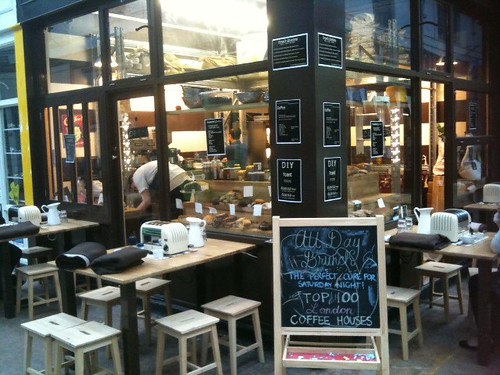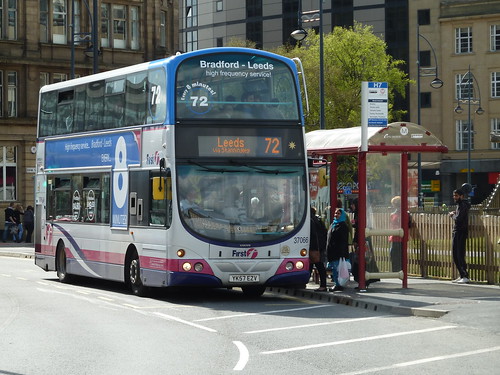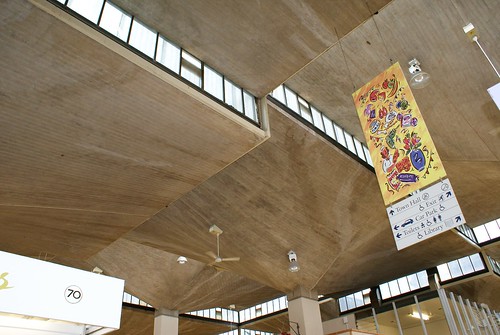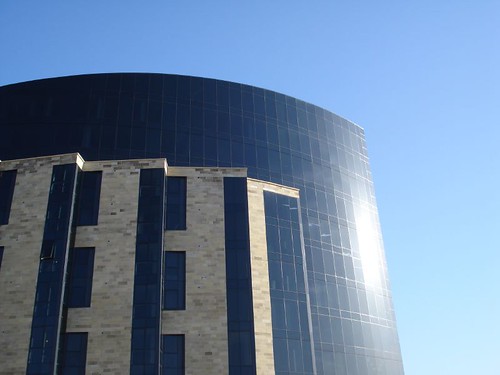Back to the
opportunities post of this blog (that is the most important post on the whole blog), of the few things listed there are several which intrinsically linked to
weaknesses and
threats that the city centre faces. The opportunities this particular blog post is looking at is: new retailers, creative use of retail space, evening economy and nightlife. These are mainly linked to the weaknesses: shopping provision and footfall; and to the threats: rents, business rates, competition from elsewhere, abandonment and spiral of decline. Clever eh?
Basically I keep thinking of what businesses would be welcome additions, that aren't too unrealistic, ones that I would run if I had the start up capital and business experience. I wish I had those things, but even if I didn't I would still be put off by the things mentioned above in weaknesses and threats. I will try and include references to existing independent businesses along the way, because there are a fair few already!
So here is a list of things that seem to work well in other places and that aren't ridiculously ambitious:
Good independent coffee shop
Bradford's not exactly lacking in coffee shops: Starbucks (x2), Caffe Nero and Costa Coffee are all in the centre. I usually go to these places for coffee and, they're ok, but I could be anywhere. There are some independent cafés, like the Red Room on Queensgate which do nice coffee and food, and Le Café Bleu on North Parade too. But it would be nice to have somewhere that was more like a coffee bar, Coffee Evolution in Huddersfield (below) comes to mind. Somewhere that serves good coffee, has free newspapers available to read and is just a little less polished than its chain counterparts and maybe does music, poetry, philosphy etc 'out of hours'. (@AtkiTeach also suggested this)
 Milkshake / Ice Cream shop
Milkshake / Ice Cream shop
I remember seeing places like Shakeaway down south, that make milkshakes with all kinds of chocolate bars etc. They seem to be popping up in more and more places now, like the two (Shakesville and Shaake) that are in Huddersfield and Shakeaholic in Leeds and the North East. Dewsbury has got a new Ice Cream parlour, Igloo, in the town centre. These places seem very popular and offer something for younger people and families (no not necessarily healthy!).
Cocktail bar
We've got some good pubs and bars in the city centre, places like the Sparrow and City Vaults are good places in their own right. I'm sure there are places that provide cocktails too, though maybe not to a more mature crowd. I think places like Font in Manchester (below), Sandinista in Leeds or Vox in Huddersfield would be very welcome additions to the Bradford night scene. Cocktails, food, good beer...
 Diverse food establishments - (half way between a restaurant or a takeaway, but not a café)
Diverse food establishments - (half way between a restaurant or a takeaway, but not a café)
The city centre has places to go for a curry, Italian restaurants, a Russian restaurant, somewhere to get Polish food; its got the usual chain places and a handful of takeaways to get food and a few cafés too and a tiny Japanese Noodle Bar in the market. But, it'd be good to have somewhere independent that hits that sweet spot between all of these. Somewhere like Elephant in Brixton Village which sells Pakistani street food or Pinto in Glasgow which sells Burritos would be nice, or a bigger version of the Japanese noodle bar! There are loads of great food places in the city, but I can't think of many in the city centre where I would want to go in on my own, eat some nice food and then just leave. Not a takeaway, not a restaurant - not sure how to explain that!
Restaurants
@TanyaVital suggested that more international restaurants would be welcome in the city centre, @KeithWildman said restaurants but not curry restaurants. I think the aforementioned Russian restaurant is a good example, but there are loads of different cultures making up the city, so international restaurants would be a good draw. It would be good for one of the big curry restaurants from the city, like Zouk or Akbars to open up in the heart of the city centre, as Bradford is the curry capital after all (and not Brick Lane).
Chocolate / confectionary shop
Other than the often much maligned Thornton's, I'm not sure what else there is in the city centre. I can't see Hotel Chocolat coming here any time soon, but if someone could learn a few things from them selling nice chocolate with good customer service, it would be welcome and I could see somewhere selling American 'candy', like Candyland in Galway, being very popular.
Card / Stationery Shop
We've got card shops, places like Clintons and ones on the market. Personally speaking, I like the foul mouthed cards they sell at Scribblr and the cards of Paperchase. Again, I can't see these coming to Bradford any time soon, but there's opportunities for an independent to capitalise here.
Clothes Shops
I buy many clothes from fairly cheap chain stores, so I'm not best qualified to speak. There are some clothes shops like TDF and AN-X in the centre already, but I'm not sure how much of a range is covered by shops in Bradford. @Atkiteach suggested more clothes shops, with an online presence, to stop his other half shopping in Leeds.
A Department Store?
Bradford is currently lacking a department store, it had Busby's many years ago, Brown Muff - later Rackhams until the 1990s and Sunwin House until the 2000s, @KeithWildman identified a department store as something that could be accommodated in Bradford. The Westfield development
when it goes ahead, is most likely to have a Debenhams in it. However, there are independent department stores still, like Psyche at Middlesbrough (below), something like that would greatly enhance Bradford's retail offer.
 Charity shops
Charity shops
I'm not joking, here. We've got loads of charity shops, these could be a lot more attractive if the goods were presented well, perhaps as vintage shops, rather than charity shops. Perhaps Bradford College fashion students could fashion up some charity shop chic? @Bonebabe suggested somewhere with a good seamstress to adjust charity shop purchases and
a personal shopper service for those of us that don't have a creative eye for a bargain.
Food Shop
@Atkiteach suggested an Asian / Oriental food shop, with a range of spices, offering an online service, there are already (market) and Sing Kee supermarket that may be offering this (though without the online part) already. etc. @FlawedMonkey said that the Polish deli from Manningham Lane would be a welcome addition to the city centre. @FlawedMonkey also suggested a bakery for the city centre (not Greggs, sorry Greggs!), I think somewhere offering a good range of treats like the village bakery in Saltaire or the Bakehouse in Huddersfield would fit right in, or somewhere to enjoy good bread like Breads Etcetera in Brixton (below). @FlawedMonkey finally suggests a health food shop, Bradford does appear to be lacking an independent shop. Personally speaking, I would like somewhere that does a good range of vegetarian and vegan food to go, like Eighth Day in Manchester or Food Therapy in Halifax.

So there you go; Bradford city centre shouldn't be like any other place, but it would be good to borrow things from Huddersfield, Dewsbury, Manchester, Leeds, Brixton, Glasgow, Galway, Manningham, Saltaire, Halifax and where ever else to become more vibrant. On reading through, it does seem a bit like a middle class wishlist, but shops and businesses like these would be very welcome in the city centre!




































